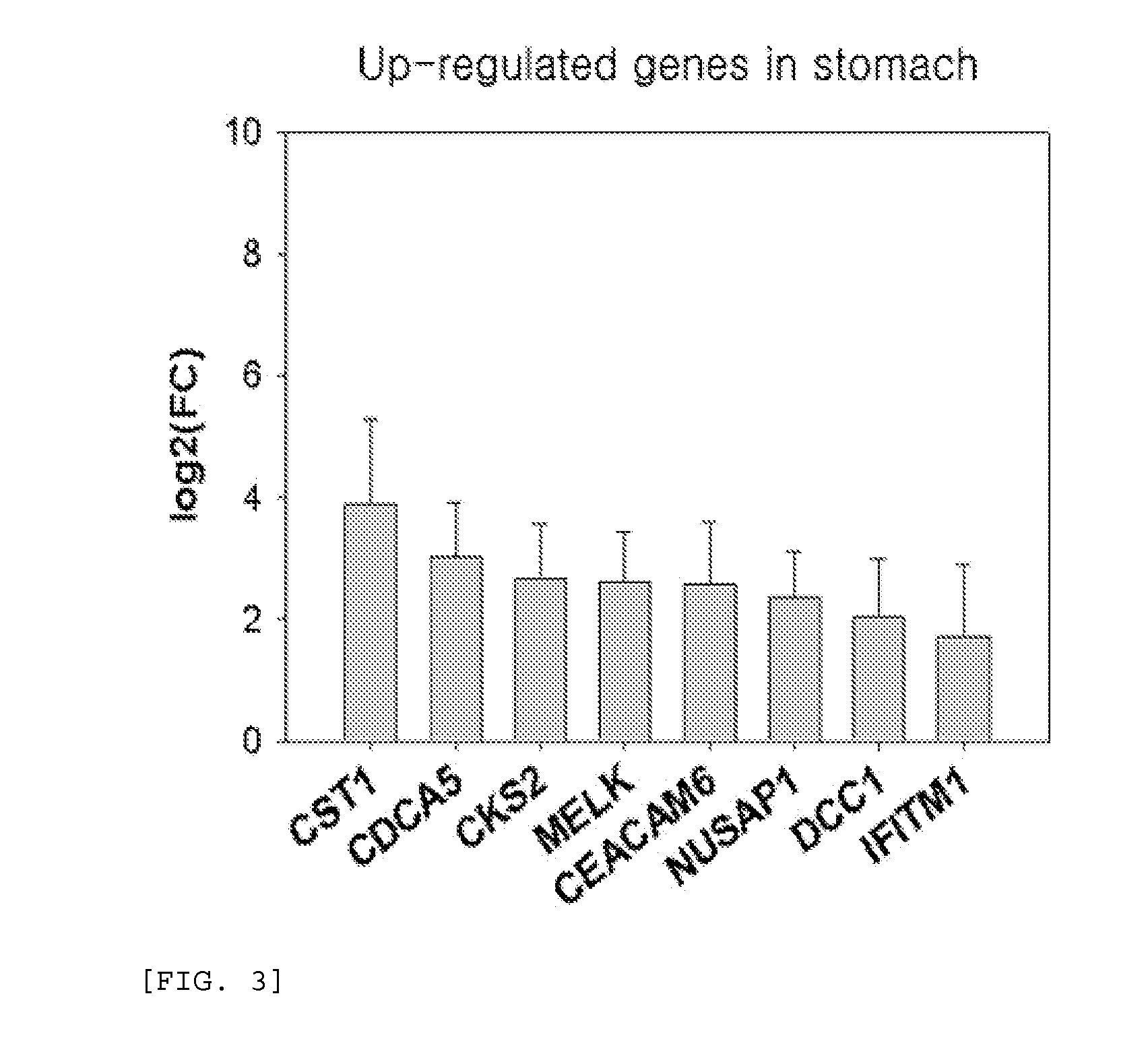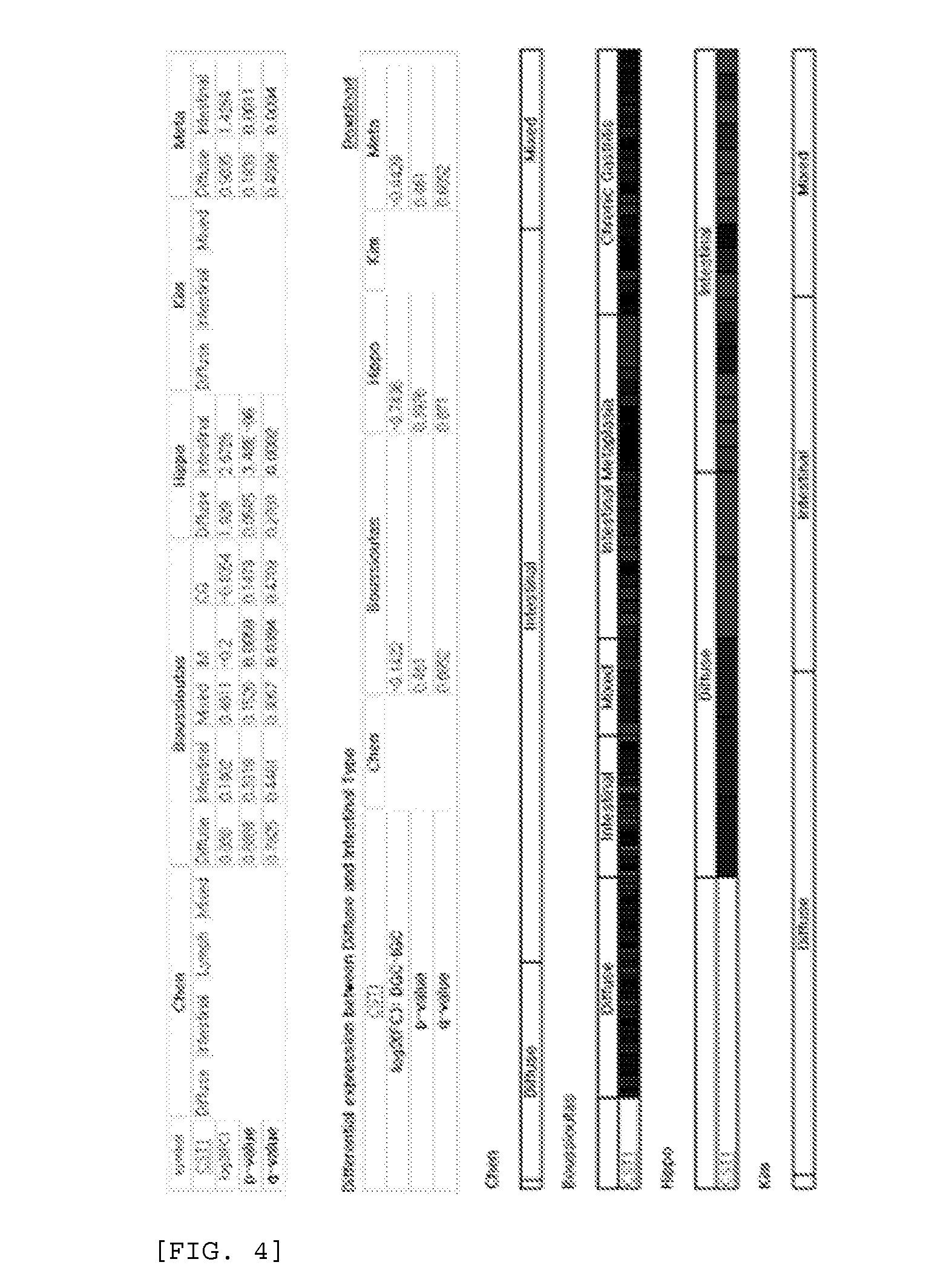CST1, DCC1, ifitm1 or melk as markers for diagnosing stomach cancer
- Summary
- Abstract
- Description
- Claims
- Application Information
AI Technical Summary
Benefits of technology
Problems solved by technology
Method used
Image
Examples
example 1
Detection of Up-Regulated Genes in Gastric Cancer by Using DNA Chip
[0070]To select genes that are specifically up-regulated in gastric cancer cells than in normal gastric epithelial cells, a DNA chip (48K human microarray, Illumina) was used to analyze the expression levels of 2,230 genes.
[0071]First, total RNAs were extracted from the normal gastric epithelial and gastric cancer cells. Extraction of the total RNA was performed using an RNeasy Mini Kit (QIAGEN), and quantified using an Experion RNA StdSens (Bio-Rad) chip. The extracted total RNA was hybridized using the Illumina TotalPrep RNA Amplification Kit (Ambion). cDNA was prepared using a T7 Oligo(dT) primer, and in vitro transcription was performed using a biotin-UTP to prepare a biotin-labeled cRNA. The prepared cRNA was quantified using NanoDrop. cRNAs that were generated from the normal gastric epithelial and gastric cancer cells were hybridized to a Human-6 V2 (Illumina) chip. Then, to remove non-specific hybridization, ...
example 2
mRNA Isolation from Tissue and Cell
[0074]For RT-PCR, normal gastric epithelial tissues and gastric cancer tissues were taken from 5 patients with gastric cancer, and mRNAs were isolated from the total 10 tissues. First, after surgical resection, the tissues were immediately washed with sterile phosphate buffered saline to remove blood, and then frozen in liquid nitrogen. Subsequently, total RNA was isolated by a guanidinium method, and single-step RNA isolation was performed. The isolated total RNA was quantified using a spectrophotometer, and then stored at a −70° C. freezer until use.
[0075]Total 7 gastric cell lines (SNU1, SNU16, SNU216, SNU484, SNU620, SNU638, AGS) were selected and obtained from Korean Cell Line Bank (KCLB: 28 Yongon-dong, Chongno-gu, Seoul, Korea). Each cell line was cultured in a suitable medium, DMEM (Invitrogen) or RPMI 1640 (Invitrogen) supplemented with 10% fetal bovine serum (FBS, Hyclon) and Penicillin / Streptomycin (1 mg / ml, Sigma) for 5-6 days, and then...
example 3
Comparison of Gene Expression by RT-PCR
[0076]4 genes were selected from the genes that were specifically up-regulated in gastric cancer, selected in Example 1, (data mining) and subjected to polymerase chain reaction. To construct primers, the entire DNA sequence of each gene was obtained from the NCBI CoreNucleotide (http: / / www.ncbi.nlm.nih.gov / ), and primer sequence thereof was designed using a Primer3 program. Polymerase chain reaction was performed using the designed primer to examine the expression level of each gene (FIG. 8). The sequence of each primer is shown in Table 2.
TABLE 2NameSize ofofproductoligo(bp)Sequence1CST1-320 bpCCA TGG CCC AGT ATC TCA GTCST1-GAA GGC ACA GGT GTC CAA GT2DCC1-331 bpGCA GCA CGA ATG CTA CTT CADCC1-CAT TTT GCA TCG AAG AAC GA3IFITM1-224 bpATG TCG TCT GGT CCC TGT TCIFITM1-TGT CAC AGA GCC GAA TAC CA4MELK-343 bpTGG CTC TCT CCC AGT AGC ATMELK-TAG CAC TGG CTT GTC CAC AG
[0077]cDNA for RT-PCR was constructed by reverse transcription using mRNA that was extr...
PUM
| Property | Measurement | Unit |
|---|---|---|
| Level | aaaaa | aaaaa |
Abstract
Description
Claims
Application Information
 Login to View More
Login to View More - R&D
- Intellectual Property
- Life Sciences
- Materials
- Tech Scout
- Unparalleled Data Quality
- Higher Quality Content
- 60% Fewer Hallucinations
Browse by: Latest US Patents, China's latest patents, Technical Efficacy Thesaurus, Application Domain, Technology Topic, Popular Technical Reports.
© 2025 PatSnap. All rights reserved.Legal|Privacy policy|Modern Slavery Act Transparency Statement|Sitemap|About US| Contact US: help@patsnap.com



